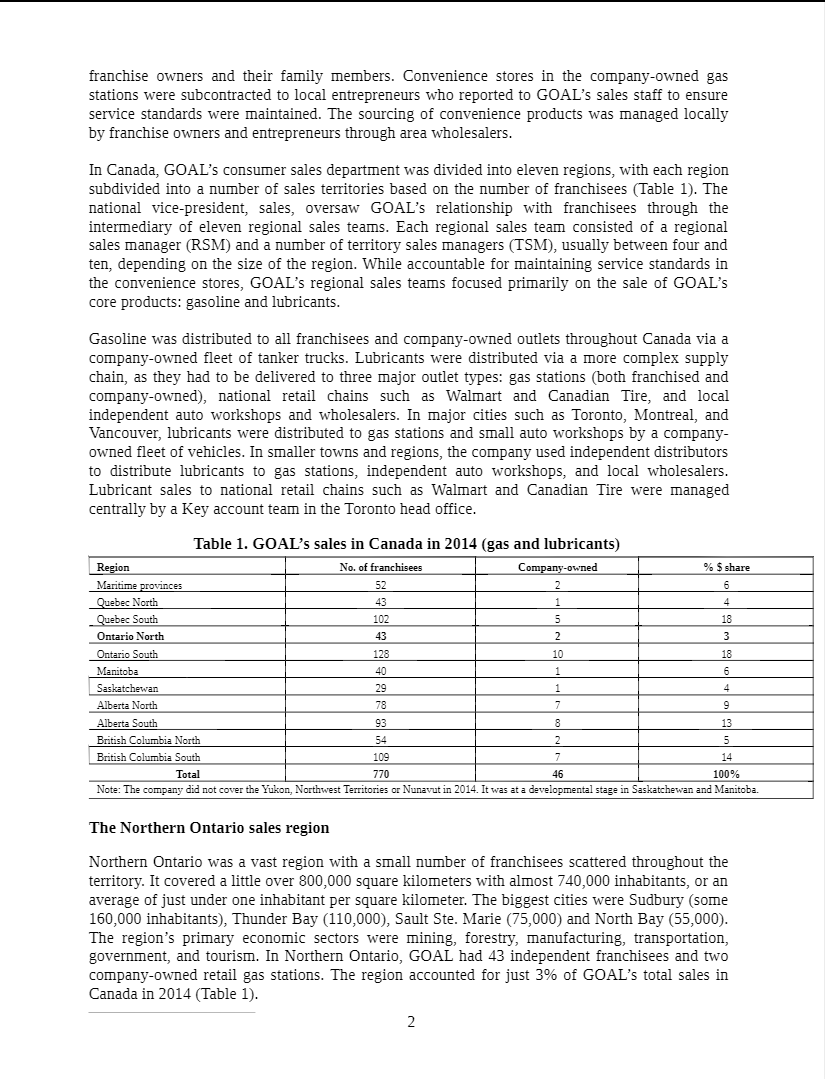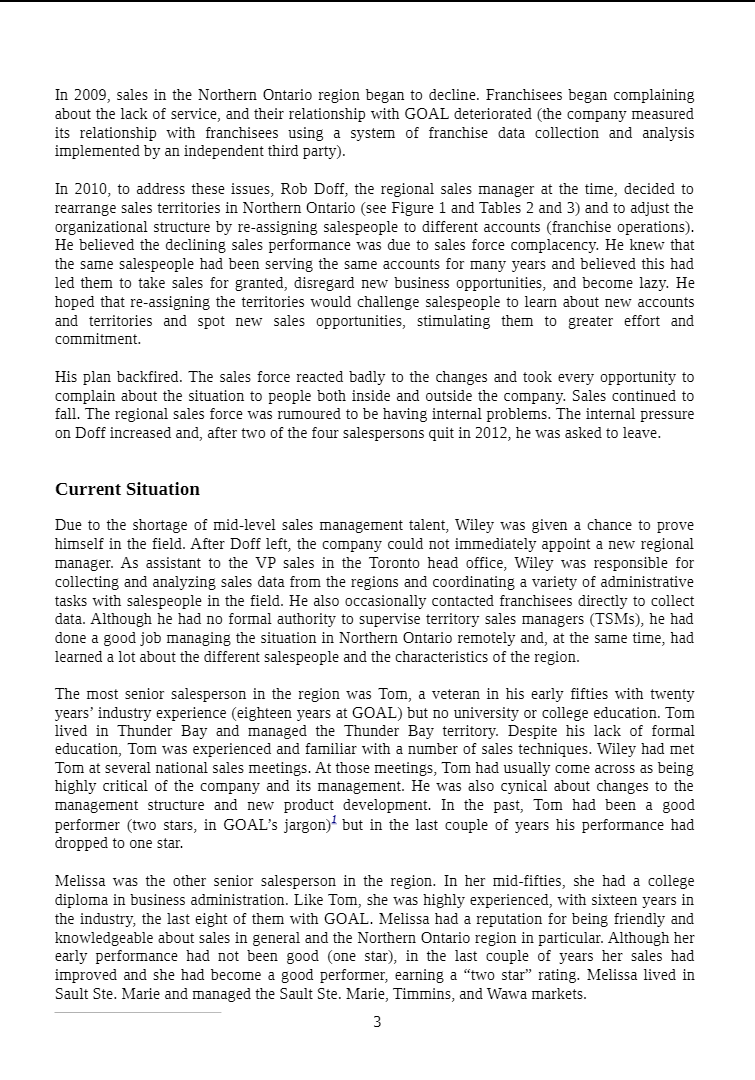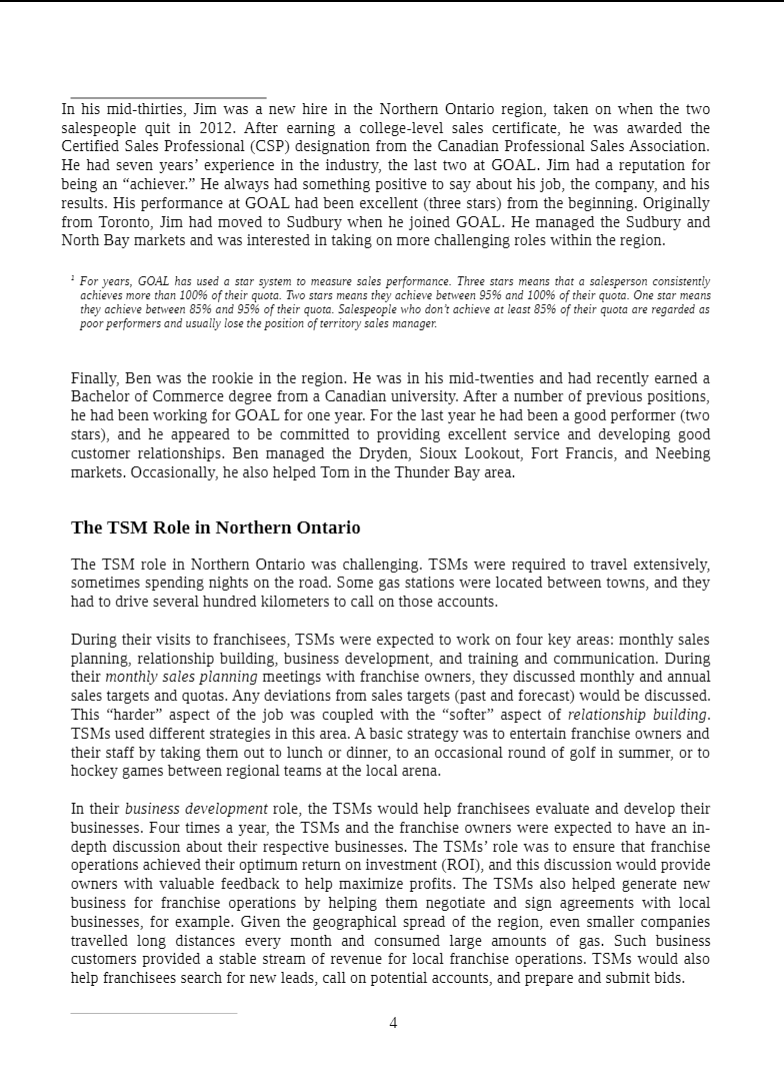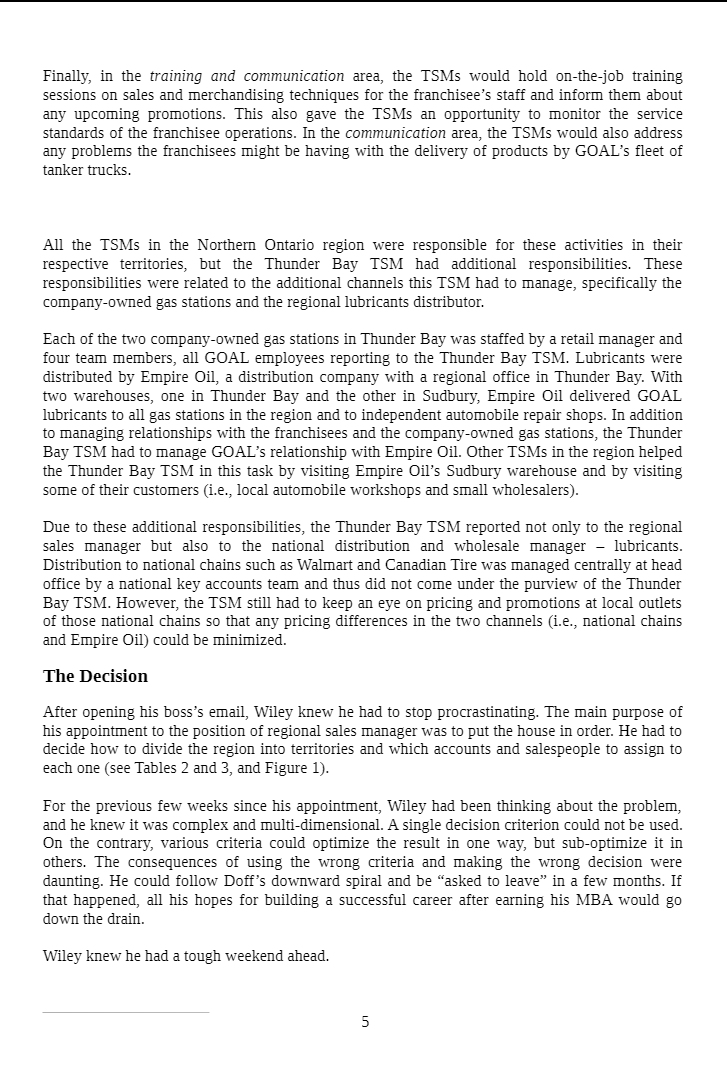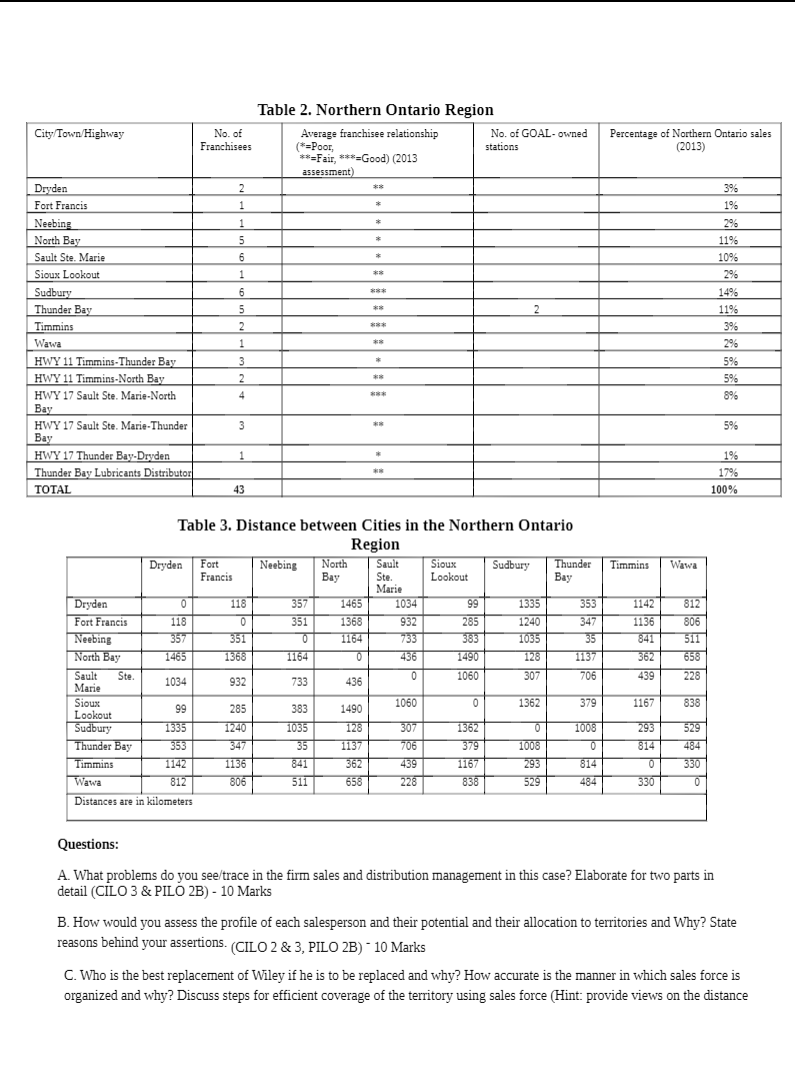Introduction It was Friday afternoon at the regional ofce of Garrick Oil and Lubricants (GOAL) in Sudbury, Ontario. An email from the national VP. sales, had just arrived. This was the email that Jonathan Wiley had been dreading for the past three weeks, ever since his appointment as regional sales manager for the Northern Ontario region. After working for five years as assistant to the national vice-president of sales, and after finishing his MBA just one month earlier, Wiley had recently received a well-deserved promotion. This opportunity for career advancement hadn't come without some personal challengesI however. He had to temporarily move from Toronto to Sudbury {385 km away) with the mandate to clear up the mess left by the previous regional sales manager. Rob Doff. His significant other had agreed to live separately, knowing that this was a temporary assignment and that if Wiley did well, he would probably get an even better position back at the company's head office in Toronto. With trembling fingers, Wiley cllcked on the email. His boss wanted to meet with him in Toronto at 10 am. on Monday momlng to review his proposal for realigning sales territories in the region. Wiley still had no idea what to suggest, but he had the whole weekend to come up with a proposal. Garrick Oil and Lubricants - Canada Garrick Oil and Lubricants was a multinational company with global headquarters in Paris, France. Active in over sixty countries, it ranked among the world's top four in the oil and gas industry. The company was known for its vertical integration and was active in all areas of the industry, including exploration and production, refining, distribution and marketing, petrochemicals, power generation, and trading. Its downstream operations [distribution and marketing of different types of gasoline, diesel oil, fuel oil, and lubricants) were handled by franchises around the world. In 2014, in the business-to-consumer end of its business, the company managed some Ni] franchised gas stations in Canada. In addition, it operated 16 company-owned gas stations in large metropolitan areas such as Toronto and Vancouver. The company-med gas stations were touted as being the "ide \" or "benchmark\" operations that franchisees were expected to emulate, thus consolidating GOAL'S control over the franchisees in the distribution channel. All of the companyowned and 80% of the franchised gas stations incorporated a small convenience store. In the case of franchised gas stations, these stores were usually run by the l franchise owners and their family members. Convenience stores in the companyowned gas stations were subcontracted to local entrepreneurs who reported to GOM's sales staff to ensure service standards were maintained. The sourcing of convenience products was managed locally by franchise owners and entrepreneurs through area wholesalers. In Canada, GOAL's consumer sales department was divided into eleven regions, with each region subdivided into a number of sales tenitories based on the number of franchisees (Table I). The national vicepresident, sales, oversaw GOAL's relationship with franchisees through the intermediary of eleven regional sales teams. Each regional sales team consisted of a regional sales manager {REM} and a number of territory sales managers {1' SM}, usually between four and ten, depending on the size of the region. While accountable for maintaining service standards in the convenience stores, GOAL's regional sales teams focused primarily on the sale of GOAL's core products: gasoline and lubricants. Gasoline was distributed to all franchisees and companyowned outlets throughout Canada via a companyowned eet of tanker trucks. Lubricants were dishibuted via a more complex supply chain, as they had to be delivered to three major outlet types: gas stations (both franchised and companyowned], national retail chains such as Walmart and Canadian Tire, and local independent auto workshops and wholesalers. In major cities such as Toronto, Montreal, and Vancouver, lubricants were dishibuted to gas stations and small auto workshops by a company- owned eet of vehicles. In smaller towns and regions, the company used independent distributors to distribute lubricants to gas stations, independent auto workshops, and local wholesalers. Lubricant sales to national retail chains such as Walmart and Canadian Tire were managed centrally by a Key account team in the Toronto head oice. Table 1. GOAL's sales in Canada in 2014 [gas and lubricants) NomThecocnp-mydiinotmrerlhemn, Nm'thwst'IeuitnliE mNtmavutm 2014. Itwasatathvelnpmntalstagoinaskatchgwanandmimba. The Northern Ontario sales region Northern Ontario was a vast region with a small number of franchisees scattered throughout the territory. It covered a little over 000,000 square kilometers with almost 140,000 inhabitants, or an average of just under one inhabitant per square kilometer. The biggest cities were Sudbury (some 150,000 inhabitants), Thunder Bay (110,000), Sault Ste. Marie (75,000) and North Bay (55,000). The region's primary economic sectors were mining, forestry, manufacturing, transportation, government, and tourism. In Northern Ontario, GOAL had 43 independent franchisees and two companyowued retail gas stations. The region accounted for just 3% of GOAL's total sales in Canada in 2014 [Table I). In 2009, sales in the Northern Ontario region began to decline. Franchisees began complaining about the lack of service, and ieir relationship with GOAL deteriorated (the company measured its relationship with franchisees using a system of franchise data collection and analysis implemented by an independent third party). In 21t}, to address these issues, Rob Do, the regional sales manager at the time, decided to rearrange sales territories in Northern Ontario (see Figure 1 and Tables 2 and 3) and to adjust the organizational struchire by reassigning salespeople to dierent accounts (franchise operations). He believed the declining sales performance was due to sales force complacency. He knew that the same salespeople had been serving the same accounts for many years and believed this had led them to take sales for granted, disregard new business opportunities, and become lazy. He hoped that reassigning the territories would challenge salespeople to learn about new accounts and territories and spot new sales oppnthnities, stimulating them to greater effort and commihnent. His plan backfired. The sales force reacted badly to the changes and took every opporhinity to complain about the situation to people both inside and outside the company. Sales continued to fall. The regional sales force was rumoured to be having internal problems. The internal pressure on Doff increased and, after two of the four salespersons quit in 21312, he was asked to leave. Current Situation Due to the shortage of midlevel sales management talent, Wiley was given a chance to prove himself in the field. After Doff left, the company could not immediately appoint a new regional manager. As assistant to the VP sales in the Toronto head office, Wiley was responsible for collecting and analyzing sales data from the regions and coordinating a variety of administrative tasks with salespeople in the field. He also occasionally contacted franchisees directly to collect data. Although he had no formal authority to supervise territory sales managers (TSMs), he had done a good job managing the situation in Northern Ontario remotely and, at the same time, had learned a lot about the different salespeople and the characteristics of the region. The most senior salesperson in the region was Tom, a veteran in his early fties with twenty years' industry experience (eighteen years at GOAL) but no university or college education. Tom lived in Thunder Bay and managed the Thunder Bay territory. Despite his lack of formal education, Tom was experienced and familiar with a number of sales tectmiques. Wiley had met Tom at several national sales meetings. At those meetings, Tom had usually come across as being highly critical of the company and its management. He was also cynical about changes to the management structure and new product development In the past, Tom had been a good performer (two stars, in GOAL's jargon}1 but in the last couple of years his performance had dropped to one star. Melissa was the oter senior salesperson in the region. In her mid-fties, she had a college diploma in business administration. Like Tom, she was highly experienced, with sixteen years in the industry, the last eight of them with GOAL. Melissa had a reputation for being friendly and loiowledgeable about sales in general and the Northern Ontario region in particular. Although her early performance had not been good (one star), in the last couple of years her sales had improved and she had become a good performer, earning a \"two star" rating. Melissa lived in Sault Ste. Marie and managed the Sault Ste. Marie, Tm1mins, and Wawa markets. 3 In his midthirties, Jim was a new hire in the Northem Ontario region, taken on when the two salespeople quit in 212. lifter earning a college-level sales certificate, be was awarded the Certified Sales Professional {ESP} designation from the Canadian Professional Sales Association. He had seven years' experience in the industry, the last two at GOAL. iirn had a reputation for being an \"achiever." He always had something positive to say about his job, the company, and his results. His performance at GOAL had been excellent [three stars] from the beginning. Originally from Toronto, Jim had moved to Sodbury when he joined GOAL. He managed the Sudbury and North Bay markets and was interested in taking on more challenging roles within the region. ' For years. GOAL has used a star system to measure sales performance. Three stars means that a salesperson consistently achieves more than 10096 of their quota. No stars mans they achieve beaveea 9396 and 10096 of their quota. One star means theyr achieve between 3396 and 9596 of their quota. Saiespeapie who don't achieve at ieast 3355 of their quota are regarded as poor performers and usually lose the position of territory sates manager. Finally, Ben was the rookie in the region. He was in his mid-twenties and had recently earned a Bachelor of Commerce degree from a Canadian university. After a number of previous positions, he had been working for GOAL for one year. For the last year he had been a good performer {boo stars], and he appeared to be committed to providing excellent service and developing good customer relationships. Ben managed the Dryden, Sioux Lookout, Fort Francis, and Neebing markets. Occasionally. he also helped Tom in the Thunder Bay area. The TSM Role in Northern Ontario The "IBM role in Northern Ontario was challenging. TSMs were required to travel extensively, sometimes spending nights on the road. Some gas stations were located between towns, and they had to drive several hundred kilometers to call on those accounts. During their visits to franchisees, TSMs were expected to work on four key areas: monthly sales planning, relationship buding, business development, and training and communication. During their monthly sales planning meetings with franchise owners, they discussed monthly and annual sales targets and quotas. Any deviations from sales targets (past and forecast] would be discussed. This \"harder\" aspect of the job was coupled with the "softer" aspect of relationship building. TSMs used different strategies in this area. Abasic strategy was to entertain franchise owners and their staff by taking them out to lunch or dinner, to an occasional round of golf in summer, or to hockey games between regional teams at the local arena. In their business development role, the TSMs would help franchisees evaluate and develop their businesses. Four times a year, the Hits and the franchise owners were expected to have an in- depth discussion about their respective businesses. The TSMs' role was to ensure that franchise operations achieved their optimum return on invesunent (ROI), and this discussion would provide owners with valuable feedback to help maximize profits. The TSivis also helped generate new business for franchise operations by helping them negotiate and sign agreements with local businesses, for example. Given the geographical spread of the region, even smaller companies travelled long distances every month and consumed large amounts of gas. Such business customers provided a stable stream of revenue for local franchise operations. TSMs would also help franchisees search for new leads, call on potential accotmts, and prepare and submit bids. 4 Finally, in the training and communication area, the ISMs would hold on-the-job training sessions on sales and merchandising techniques for the franchisee's staff and inform them about any upcoming promotions. This also gave the TSMs an opportunity to monitor the service standards of the franchisee operations. In the communication area, the TSMs would also address any problems the franchisees might be having with the delivery of products by GOAL's fleet of tanker trucks. All the ISMs in the Northern Ontario region were responsible for these activities in their respective territories, but the Thunder Bay TSM had additional responsibilities. These responsibilities were related to the additional channels this TSM had to manage, specifically the company-owned gas stations and the regional lubricants distributor. Each of the two company-owned gas stations in Thunder Bay was staffed by a retail manager and four team members, all GOAL employees reporting to the Thunder Bay TSM. Lubricants were distributed by Empire Oil, a distribution company with a regional office in Thunder Bay. With two warehouses, one in Thunder Bay and the other in Sudbury, Empire Oil delivered GOAL lubricants to all gas stations in the region and to independent automobile repair shops. In addition to managing relationships with the franchisees and the company-owned gas stations, the Thunder Bay TSM had to manage GOAL's relationship with Empire Oil. Other TSMs in the region helped the Thunder Bay TSM in this task by visiting Empire Oil's Sudbury warehouse and by visiting some of their customers (i.e., local automobile workshops and small wholesalers). Due to these additional responsibilities, the Thunder Bay TSM reported not only to the regional sales manager but also to the national distribution and wholesale manager - lubricants. Distribution to national chains such as Walmart and Canadian Tire was managed centrally at head office by a national key accounts team and thus did not come under the purview of the Thunder Bay TSM. However, the TSM still had to keep an eye on pricing and promotions at local outlets of those national chains so that any pricing differences in the two channels (i.e., national chains and Empire Oil) could be minimized. The Decision After opening his boss's email, Wiley knew he had to stop procrastinating. The main purpose of his appointment to the position of regional sales manager was to put the house in order. He had to decide how to divide the region into territories and which accounts and salespeople to assign to each one (see Tables 2 and 3, and Figure 1). For the previous few weeks since his appointment, Wiley had been thinking about the problem, and he knew it was complex and multi-dimensional. A single decision criterion could not be used. On the contrary, various criteria could optimize the result in one way, but sub-optimize it in others. The consequences of using the wrong criteria and making the wrong decision were daunting. He could follow Doff's downward spiral and be "asked to leave" in a few months. If that happened, all his hopes for building a successful career after earning his MBA would go down the drain. Wiley knew he had a tough weekend ahead.Table 2. Northern Ontario Region City/Town/Highway No. of Average franchisee relationship No. of GOAL- owned Percentage of Northern Ontario sales Franchisees *=Poor, stations (2013) **=Fair, ***=Good) (2013 assessment) Dryden 2 3% Fort Francis 1 1% Neebing 2% North Bay 11% Sault Ste. Marie 6 * 10% Sioux Lookout 2% Sudbury 14% Thunder Bay 2 11% Timmins INWHNUIC HC 3% Wawa 29% HWY 11 Timmins-Thunder Bay 5% HWY 11 Timmins-North Bay 5% HWY 17 Sault Ste. Marie-North 896 Bay HWY 17 Sault Ste. Marie-Thunder 3 5% Bay HWY 17 Thunder Bay-Dryden 1% Thunder Bay Lubricants Distributor 17% TOTAL 43 100% Table 3. Distance between Cities in the Northern Ontario Region Dryden Fort Neebing North Sault Sioux Sudbury Thunder Timmins Wawa Francis Bay Ste. Lookout Bay Marie Dryden 0 118 357 1465 1034 99 1335 353 1142 812 Fort Francis 118 351 1368 932 285 1240 347 1136 806 Neebing 357 351 1164 733 383 1035 35 841 511 North Bay 1465 1368 1164 436 1490 128 1137 362 658 Sault Ste 1034 937 733 436 1060 307 706 439 228 Marie Sioux 99 285 383 1490 1060 1362 379 1167 838 Lookout Sudbury 1335 1240 1035 128 307 1362 1008 293 529 Thunder Bay 353 347 35 1137 706 379 1008 0 814 484 Timmins 142 1136 841 362 439 1167 293 814 0 330 Wawa 812 806 511 658 228 838 529 484 330 Distances are in kilometers Questions: A. What problems do you see/trace in the firm sales and distribution management in this case? Elaborate for two parts in detail (CILO 3 & PILO 2B) - 10 Marks B. How would you assess the profile of each salesperson and their potential and their allocation to territories and Why? State reasons behind your assertions. (CILO 2 & 3, PILO 2B) - 10 Marks C. Who is the best replacement of Wiley if he is to be replaced and why? How accurate is the manner in which sales force is organized and why? Discuss steps for efficient coverage of the territory using sales force (Hint: provide views on the distance

